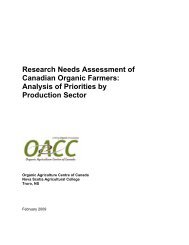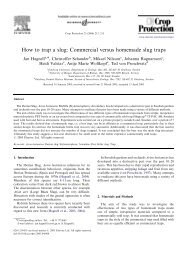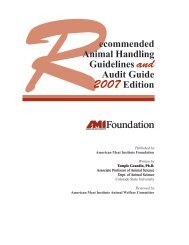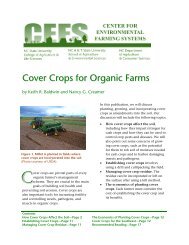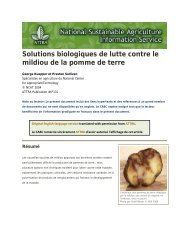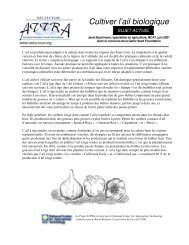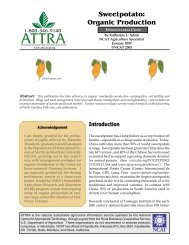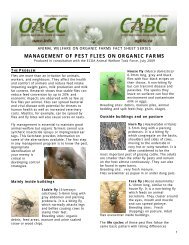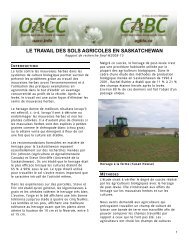You also want an ePaper? Increase the reach of your titles
YUMPU automatically turns print PDFs into web optimized ePapers that Google loves.
<str<strong>on</strong>g>Crop</str<strong>on</strong>g> <str<strong>on</strong>g>Rotati<strong>on</strong>s</str<strong>on</strong>g> <strong>on</strong> <strong>Organic</strong> <strong>Farms</strong>by Keith R. BaldwinFarmers in ancient cultures as diverseas those of China, Greece, and Romeshared a comm<strong>on</strong> understandingabout crop rotati<strong>on</strong>s. They learned fromexperience that growing the same crop yearafter year <strong>on</strong> the same piece of landresulted in low yields, and that they coulddramatically increase productivity <strong>on</strong> theland by cultivating a sequence of crops overseveral seas<strong>on</strong>s. TheyIf improved soilaggregati<strong>on</strong> andtilth are afarmer’s goals,l<strong>on</strong>g-termrotati<strong>on</strong>s shouldbe part of afarm plan.came to understandhow crop rotati<strong>on</strong>s,combined with suchpractices as covercrops and greenmanures, enhancedsoil organic matter,fertility, and tilth.For a variety of otherreas<strong>on</strong>s that we will explore in thispublicati<strong>on</strong>, crops can and should bemanaged in rotati<strong>on</strong>s. No <strong>on</strong>e disputes thefact that rotati<strong>on</strong>s are beneficial. The use oftwo- and three-year rotati<strong>on</strong>s by theC<strong>on</strong>tentsA Historical Perspective—Page 2<str<strong>on</strong>g>Crop</str<strong>on</strong>g> <str<strong>on</strong>g>Rotati<strong>on</strong>s</str<strong>on</strong>g> versus C<strong>on</strong>tinuous <str<strong>on</strong>g>Crop</str<strong>on</strong>g>ping—Page 3Figure 1. Soybeans are often part of anorganic rotati<strong>on</strong> schedule in the South.Photo courtesy of USDA.majority of the grain farmers in thiscountry shows they agree that yields aregenerally higher when crops are grown<str<strong>on</strong>g>Crop</str<strong>on</strong>g> <str<strong>on</strong>g>Rotati<strong>on</strong>s</str<strong>on</strong>g> and Fertility—Page 5<str<strong>on</strong>g>Crop</str<strong>on</strong>g> <str<strong>on</strong>g>Rotati<strong>on</strong>s</str<strong>on</strong>g> and Pest Management—Page 9Recommended Reading—Page 14
sequentially in rotati<strong>on</strong>s. In thispublicati<strong>on</strong>, we will discuss crop rotati<strong>on</strong>sas key strategies that farmers can use tobuild the soil, manage pests, and increaseyields. Our discussi<strong>on</strong> will be organizedaround the following topics:• A historical perspective. We willdescribe how crop rotati<strong>on</strong>s fit into thehistory of farming in America,particularly in the South, and howmodern c<strong>on</strong>venti<strong>on</strong>al farming methodshave altered the way some farmerspractice crop rotati<strong>on</strong>s.• <str<strong>on</strong>g>Crop</str<strong>on</strong>g> rotati<strong>on</strong>s versus c<strong>on</strong>tinuouscropping. We will summarize theresults of several scientific studies thathave compared the impacts of l<strong>on</strong>gandshort-term rotati<strong>on</strong>s andc<strong>on</strong>tinuous cropping, or m<strong>on</strong>oculture, <strong>on</strong>soil properties. These studies indicatethat using crop rotati<strong>on</strong>s can lead todramatic increases in soil fertility, helpto optimize nutrient and water use bycrops, and improve our soil resources.• <str<strong>on</strong>g>Crop</str<strong>on</strong>g> rotati<strong>on</strong>s and soil fertility. Wewill describe the use of crop rotati<strong>on</strong>s toimprove fertility.• <str<strong>on</strong>g>Crop</str<strong>on</strong>g> rotati<strong>on</strong>s and pest management.We will describe the use of croprotati<strong>on</strong>s to manage pests, includingdiseases, weeds, and insects.C<strong>on</strong>tinuous <str<strong>on</strong>g>Crop</str<strong>on</strong>g>pingIn the South, c<strong>on</strong>tinuous cropping thatincorporates organic matter is better thanfallow periods for the soil. During fallowperiods, biomass additi<strong>on</strong>s are not made tothe soil. However, mineralizati<strong>on</strong> of organicmatter in the soil c<strong>on</strong>tinues during fallowperiods, thus leading to reducti<strong>on</strong>s in organicmatter.A HISTORICAL PERSPECTIVEThere was a time in America when the useof l<strong>on</strong>g-term crop rotati<strong>on</strong>s figuredprominently in every farmer’s plans toboost soil fertility and c<strong>on</strong>trol crop pestsand diseases. But since the 1950s, farmersincreasingly have replaced crop rotati<strong>on</strong>swith modern practices, such as usingsynthetic fertilizers to supply annual cropnutrients, applying agri-chemicals toc<strong>on</strong>trol pests and diseases, and selectingimproved crop varieties for increased yields.Many farmers still use crop rotati<strong>on</strong>s, but inmuch shorter cycles. For instance,approximately 80 percent of the U.S. corncrop is now grown in two-year rotati<strong>on</strong>swith soybeans or three-year rotati<strong>on</strong>s withsoybeans and wheat. These short, two- tothree-year rotati<strong>on</strong>s rarely include pastures,cover crops, or green manures. Thesemodern cropping systems have allowedAmerican farmers to benefit fromec<strong>on</strong>omies of scale by specializing theiroperati<strong>on</strong>s and marketing crops in volume.And these systems require fewer pieces ofequipment because the crops grown are lessdiverse.Such modern farming practices have helpedU.S. farmers to produce remarkable cropyields. Nevertheless, the use of intensivecropping for the past 50 years has causedsome negative impacts <strong>on</strong> ourenvir<strong>on</strong>ment, especially <strong>on</strong> our farm soils.Today, the biggest risks for farmers aredeclining soil quality and increasingenvir<strong>on</strong>mental degradati<strong>on</strong>. As a result,researchers are <strong>on</strong>ce again focusing <strong>on</strong> croprotati<strong>on</strong>s as a primary way to attainsustainable crop producti<strong>on</strong>, improvedyields, and the ec<strong>on</strong>omic returns thatsupport a diversified rural ec<strong>on</strong>omy.<strong>Organic</strong> Producti<strong>on</strong>—<str<strong>on</strong>g>Crop</str<strong>on</strong>g> <str<strong>on</strong>g>Rotati<strong>on</strong>s</str<strong>on</strong>g> <strong>on</strong> <strong>Organic</strong> <strong>Farms</strong> 2
In the South, farmers historically have usedcrop rotati<strong>on</strong>s in the producti<strong>on</strong> of cott<strong>on</strong>,tobacco, and peanuts. For example, thesewere traditi<strong>on</strong>al rotati<strong>on</strong>s for tobacco in theearly 20th century:• tobacco—wheat—clover,• tobacco—wheat—cowpea, or• tobacco—wheat—red clover—mixedforages—corn.The cowpea was generally included whenlegumes were used as a green manure tomaintain soil humus.Cott<strong>on</strong> rotati<strong>on</strong>s were similar to those fortobacco. Other crops in the rotati<strong>on</strong> wereselected to maintain soil humus c<strong>on</strong>tent,for their potential as livestock feed, or both.On livestock farms, a rotati<strong>on</strong> of corn—oats—wheat—clover—pasture was oftenemployed to produce livestock feed.<str<strong>on</strong>g>Crop</str<strong>on</strong>g> <str<strong>on</strong>g>Rotati<strong>on</strong>s</str<strong>on</strong>g>: The Benefits• Build soil fertility.• Preserve the envir<strong>on</strong>ment.• Boost ec<strong>on</strong>omic returns.• Aid c<strong>on</strong>trol of weeds, diseases, andharmful insects.• Add to crop and market diversity.CROP ROTATIONS VERSUSCONTINUOUS CROPPINGAs discussed in other publicati<strong>on</strong>s withinthis series, organic farmers work toward akey goal: to improve soil quality andstructure. This goal isn’t accomplishedovernight. It takes years of c<strong>on</strong>certed effortto feed the soil and build a friable soilstructure with these characteristics:• Nutrients and water reside in a soilnutrient reservoir or pool and becomeavailable to plants over both the shortand l<strong>on</strong>g term.• A healthy microbial pool of livingmicroorganisms exists to facilitatenutrient cycling from the nutrientreservoir to plant roots.• A natural ecosystem is established thatserves as an envir<strong>on</strong>mental filter. Thisfilter helps to protect the agroecosystemfrom potentially adversefarming practices and envir<strong>on</strong>mentalcalamities.Soil <strong>Organic</strong> Matter<strong>Organic</strong> farmers often judge and m<strong>on</strong>itorsoil health based <strong>on</strong> the amount of organicmatter in each farm field. Active soilorganic matter refers to a diverse mix ofliving and dead organic materials near thesoil surface that turn over or recycle every<strong>on</strong>e to two years. Active organic matterserves as a biological pool of the major plantnutrients. The balance between the decayand renewal processes in this biologicalpool is very complex and sensitive. Thepopulati<strong>on</strong>s of microorganisms that makeup the biological pool are the driving forcesin soil nutrient dynamics. Together theyalso play a key role in building a soilstructure that both retains and freelyexchanges nutrients and water—a soilwhere plant roots thrive.<str<strong>on</strong>g>Crop</str<strong>on</strong>g> <str<strong>on</strong>g>Rotati<strong>on</strong>s</str<strong>on</strong>g> and Soil <strong>Organic</strong> MatterWhich crop rotati<strong>on</strong> factors affect soil organicmatter?• Rotati<strong>on</strong> length• Loss of organic matter from tillageoperati<strong>on</strong>s• Interacti<strong>on</strong>s with fertilizati<strong>on</strong> practicesSource: Karlen et al., 1994<strong>Organic</strong> Producti<strong>on</strong>—<str<strong>on</strong>g>Crop</str<strong>on</strong>g> <str<strong>on</strong>g>Rotati<strong>on</strong>s</str<strong>on</strong>g> <strong>on</strong> <strong>Organic</strong> <strong>Farms</strong> 3
C<strong>on</strong>venti<strong>on</strong>al TillageIt’s easy to see how this delicate worldbeneath the soil surface can be affected soreadily <strong>on</strong>e way or the other by variouscropping systems. Imagine the impact <strong>on</strong>soil fertility, structure, and nutrientprocesses when the soil is turned up andmixed regularly. Many studies have shownthat in most c<strong>on</strong>venti<strong>on</strong>ally tilledagricultural soils, both soil organic matterand microbial activity decrease. Althoughbulk organic matter may still exist undersome high-tillage systems, active soilorganic matter is lost.Extensive tillage stimulates microbialactivity by providing soil microorganismswith the oxygen they need to break downor c<strong>on</strong>sume organic matter. Populati<strong>on</strong>s ofmicroorganisms build quickly under thesecircumstances and actively decompose anyamendments, green manures, or cropresidues that are turned in with tillage.<strong>Organic</strong> matter doesn’t normallyaccumulate in the soil under thesec<strong>on</strong>diti<strong>on</strong>s.Because they do not generally include greenmanure or forage crops, c<strong>on</strong>tinuouscropping and short-term rotati<strong>on</strong>al systems(systems that use two- or three-yearrotati<strong>on</strong>s) deplete soil organic matter levels.As a result, soil structure—as measured bysoil aggregate stability, soil bulk density,water infiltrati<strong>on</strong>, and soil erosi<strong>on</strong>—candegrade.Effective <str<strong>on</strong>g>Crop</str<strong>on</strong>g> <str<strong>on</strong>g>Rotati<strong>on</strong>s</str<strong>on</strong>g><str<strong>on</strong>g>Rotati<strong>on</strong>s</str<strong>on</strong>g> are most effective whencombined with such practices as manuring,composting, cover cropping, greenmanuring, and short pasturing cycles.Together, these practices create soil qualityimprovements such as increased soilaggregate stability, decreased crusting ofsoil surfaces, and increased granularstructure and friable c<strong>on</strong>sistence. <str<strong>on</strong>g>Rotati<strong>on</strong>s</str<strong>on</strong>g>that include sod, pasture, or hay crops alsohelp to decrease bulk soil density, whichcan greatly impede root growth andnutrient flow. Simply put, managementsystems that maintain or increase soilorganic matter have the potential forincreasing soil productivity for all croppingsystems, including organic systems.<str<strong>on</strong>g>Crop</str<strong>on</strong>g> <str<strong>on</strong>g>Rotati<strong>on</strong>s</str<strong>on</strong>g> and Soil Erosi<strong>on</strong>Farmers who practice l<strong>on</strong>g-term crop rotati<strong>on</strong>can reduce soil erosi<strong>on</strong> <strong>on</strong> their land. A studyc<strong>on</strong>ducted in 1988 found 6 inches moretopsoil <strong>on</strong> an organic farm than <strong>on</strong> anadjacent c<strong>on</strong>venti<strong>on</strong>al farm in the Palouseregi<strong>on</strong> of Washingt<strong>on</strong> state.The 7,700-acre organic farm had beenmanaged without the use of commercialfertilizers and with limited use of approvedpesticides since its soil was first plowed in1909. Researchers compared the organicfarm’s topsoil to that of a nearby c<strong>on</strong>venti<strong>on</strong>alfarm. The 1,400-acre c<strong>on</strong>venti<strong>on</strong>al farm, firstcultivated in 1908, began receivingrecommended rates of commercial fertilizersin 1948 and pesticides in the early 1950s.The difference in topsoil depth between thetwo farms was attributed to significantlygreater erosi<strong>on</strong> <strong>on</strong> the c<strong>on</strong>venti<strong>on</strong>al farmbetween 1948 and 1985. Researchersattributed the difference in erosi<strong>on</strong> rates tocrop rotati<strong>on</strong> because the organic farmerincluded green manure crops within therotati<strong>on</strong> plan while the c<strong>on</strong>venti<strong>on</strong>al farmerdid not.Source: Reganold et al, 1988<strong>Organic</strong> Producti<strong>on</strong>—<str<strong>on</strong>g>Crop</str<strong>on</strong>g> <str<strong>on</strong>g>Rotati<strong>on</strong>s</str<strong>on</strong>g> <strong>on</strong> <strong>Organic</strong> <strong>Farms</strong> 4
CROP ROTATIONS AND SOILFERTILITYU.S. farmers so<strong>on</strong> may have no choice as toadopting such practices as crop rotati<strong>on</strong>s.Alarming increases in nitrogenc<strong>on</strong>centrati<strong>on</strong>s in surface and groundwaterhave been attributed to the use of nitrogenand phosphorous fertilizers <strong>on</strong> farms. Suchproblems may result in laws mandating bestnutrient management practices <strong>on</strong> farms.<str<strong>on</strong>g>Crop</str<strong>on</strong>g> <str<strong>on</strong>g>Rotati<strong>on</strong>s</str<strong>on</strong>g>:Match Profits with PracticesThe challenge for farmers practicing croprotati<strong>on</strong> is this: to define systems thatmaintain farm profits with practices thatimprove soil quality and preventenvir<strong>on</strong>mental degradati<strong>on</strong>.Farmers may want to c<strong>on</strong>sider such opti<strong>on</strong>s asalternative crops, double and triple cropping,value-added enterprises (such as producingcover crop seed or forages and green manuresfor composting), or a combinati<strong>on</strong> of all ofthese.runoff or leach. Researchers estimate thatfrom 40 to 75 percent of the total nitrogenc<strong>on</strong>tained in a legume cover crop isavailable in the soil for subsequent crops,depending <strong>on</strong> envir<strong>on</strong>mental c<strong>on</strong>diti<strong>on</strong>s.In additi<strong>on</strong>, trap crops like small grains canbe used to capture leftover nitrogen fromfarm fields after a harvest of cash crops.Small grains have extensive, fibrous rootsystems that can effectively mine the soilfor available nitrogen. By capturing andstoring residual soil nitrogen, these trapcrops prevent this nitrogen from leachingor running off farm fields.Phosphorus and PotassiumThe effect of crop rotati<strong>on</strong>s <strong>on</strong> soil nitrogen(N), phosphorous (P), potassium (K) andcarb<strong>on</strong> (C) is very complex. Southeasternorganic farmers report that including deeprootedcover crops in rotati<strong>on</strong>s helps tobetter distribute phosphorous andpotassium from deep within the soil profileto the soil surface, where plant roots havebetter access to them.NitrogenFarmers use a best nutrient managementpractice when they use legumes in croprotati<strong>on</strong>s to supply biologically fixed,atmospheric nitrogen as a replacement orsupplement for inorganic nitrogenfertilizer. The amount of nitrogen inlegume cover crops varies am<strong>on</strong>g species,but legumes generally c<strong>on</strong>tribute 50 to 200pounds of nitrogen per acre. This nitrogenis mineralized over an extended period oftime, so that any surpluses of it do notreadily run off into streams andunderground water supplies. The nitrogenin c<strong>on</strong>venti<strong>on</strong>al fertilizers, however, isavailable immediately and surpluses canSoil <strong>Organic</strong> Carb<strong>on</strong> Reflects Soil QualitySoil organic carb<strong>on</strong> (SOC) is an importantindicator of soil quality because it influencessoil structure. Soil structure affects soilstability, as well as its capacity to hold water,and it is a driving force in nutrient cycling.Equilibrium c<strong>on</strong>centrati<strong>on</strong>s of SOC in agroecosystemsare the direct result of the farmingpractices implemented <strong>on</strong> the land.<strong>Organic</strong> farmers can attempt to build higherSOC with sustainable farming practices.However, they should realize that following achange in land management, SOC changesslowly.<strong>Organic</strong> Producti<strong>on</strong>—<str<strong>on</strong>g>Crop</str<strong>on</strong>g> <str<strong>on</strong>g>Rotati<strong>on</strong>s</str<strong>on</strong>g> <strong>on</strong> <strong>Organic</strong> <strong>Farms</strong> 5
<strong>Organic</strong> farmers have reported manybeneficial effects from crop rotati<strong>on</strong>s <strong>on</strong>phosphorous relati<strong>on</strong>ships in the soil.According to these farmers, crop plantsraised in rotati<strong>on</strong>s generally have betterroot functi<strong>on</strong>, and so are better able to takeup phosphorous from the soil. The farmerspoint out that rotati<strong>on</strong>s employing greenmanures have a tendency to increase soilmicrobial activity, as well as plant-availablephosphorous. Finally, the enhancednutrient cycling that results from croprotati<strong>on</strong>s increases the amount of twoplant-available forms of phosphorous in thesoil: biomass phosphorous and labileorganic phosphorous.<str<strong>on</strong>g>Crop</str<strong>on</strong>g> <str<strong>on</strong>g>Rotati<strong>on</strong>s</str<strong>on</strong>g> Boost N, C, P, and K in SoilsA team of researchers reported in a 1998 issueof Agr<strong>on</strong>omy Journal that the use of rotati<strong>on</strong>alorganic farming practices over an eight-yearperiod increased soil organic carb<strong>on</strong>, solublephosphorous, exchangeable potassium, andsoil pH (acidity measurements).At the c<strong>on</strong>clusi<strong>on</strong> of the eight-year trial, soilorganic carb<strong>on</strong> was 2 percent higher in a fieldwhere organic rotati<strong>on</strong>al practices were usedthan in a baseline field where c<strong>on</strong>venti<strong>on</strong>alpractices and a two-year rotati<strong>on</strong> scheme wasused. Likewise, total soil nitrogen was 22percent higher in the organic field than in thebaseline c<strong>on</strong>venti<strong>on</strong>al field.Source: Clark et al. (1998)Light and Heavy Feeders<strong>Organic</strong> farmers often base their croprotati<strong>on</strong>s <strong>on</strong> whether various plants in therotati<strong>on</strong>al lineup are light or heavy feeders.<str<strong>on</strong>g>Crop</str<strong>on</strong>g>s differ in their ability to extract waterand nutrients from the soil. Some plantswith shallow roots feed near the surface;others have root systems that explore thesoil at lower depths (Table 1). Following ashallow-rooted crop like <strong>on</strong>i<strong>on</strong>s or carrots,organic farmers may plant deeper-rootedcrops like corn to recover nutrients thatwere unused by the shallow feeders andmay have leached by irrigati<strong>on</strong> or rainfallto lower depths in the soil profile.C<strong>on</strong>versely, these farmers sometimes followdeep-rooted heavy feeders with shallowrootedlight feeders to scavenge nutrientsthat may remain after heavy applicati<strong>on</strong>s ofnutrients.Examples of Light and Heavy FeedersSome crops are heavyfeeders that deplete soils,while other crops are lightfeeders that build soils.Soil Depleting <str<strong>on</strong>g>Crop</str<strong>on</strong>g>sRow crops — corn, soybeans, vegetables,potatoesSoil Neutral or Soil C<strong>on</strong>serving <str<strong>on</strong>g>Crop</str<strong>on</strong>g>sCereal crops — wheat, barley, oatsSoil Building <str<strong>on</strong>g>Crop</str<strong>on</strong>g>sLegume sods — alfalfa, cloverGrass sods — prairie grass, meadows, pasturesCover <str<strong>on</strong>g>Crop</str<strong>on</strong>g>sWarm-seas<strong>on</strong> legumes, grown as covercrops, figure prominently in every rotati<strong>on</strong><strong>on</strong> an organic farm. This is because they area primary source of nitrogen for other cropsin the organic rotati<strong>on</strong>. In most years,growing a winter legume like hairy vetch orcrims<strong>on</strong> clover will provide all thebiological nitrogen necessary for a summercash crop. Warm-seas<strong>on</strong> legumes likecowpeas, sunnhemp or soybeans also offeropportunities for biological nitrogenfixati<strong>on</strong> during the summer seas<strong>on</strong>.Legumes often follow spring crops or<strong>Organic</strong> Producti<strong>on</strong>—<str<strong>on</strong>g>Crop</str<strong>on</strong>g> <str<strong>on</strong>g>Rotati<strong>on</strong>s</str<strong>on</strong>g> <strong>on</strong> <strong>Organic</strong> <strong>Farms</strong> 6
precede fall vegetable crops in organicrotati<strong>on</strong>s.Based <strong>on</strong> calculati<strong>on</strong>s of how quickly aparticular cover crop will decompose whenincorporated into the soil, organic farmersmay choose to follow the crop with either alight or heavy feeding crop. If the expectedrate of decompositi<strong>on</strong> of cover cropbiomass is rapid and biomass-nitrogen yieldis expected to be high (such as a succulentwinter legume killed in mid-May), a farmermay want to plant a heavy feeder. If theexpected rate of decompositi<strong>on</strong> is slow(such as a mature cereal grain) or biomassproducti<strong>on</strong> may be low (such as a legumekilled in late March), a farmer may want tofollow with a light feeder.Cover <str<strong>on</strong>g>Crop</str<strong>on</strong>g>s and Soil Moisture.Farmers must be aware of the impact ofcover crops <strong>on</strong> soil moisture, especially indry years. Cash crops can suffer fromdrought stress in the spring when apreviously grown cover crop has drawndown soil moisture. Germinati<strong>on</strong> may alsobe reduced or delayed, which has anadverse impact <strong>on</strong> early seas<strong>on</strong> growth andfinal yield. Alternatively, in wet years, covercrops can help to deplete soil moisture andallow earlier field operati<strong>on</strong>s. Duringdroughty years, decompositi<strong>on</strong> ofincorporated legume biomass in dry soilsmay be slower than normal, so the releaseof biological nitrogen may be inhibited. Asa result, yields might be reduced by earlyseas<strong>on</strong>nitrogen deficiency. This can becountered with additi<strong>on</strong>s of nitrogenfertilizer.EXAMPLEHow Cover <str<strong>on</strong>g>Crop</str<strong>on</strong>g>s Are Included in <str<strong>on</strong>g>Crop</str<strong>on</strong>g><str<strong>on</strong>g>Rotati<strong>on</strong>s</str<strong>on</strong>g>A farmer decides to plant tomatoes, which arerelatively heavy feeders, in late spring after alldanger of frost has passed. In the late spring,in preparati<strong>on</strong> for planting tomatoes, thefarmer incorporates a hairy vetch cover cropinto the soil to add organic matter andnitrogen to the soil.The farmer chose hairy vetch as a cover cropbecause he/she knew that tomato plants needan early-seas<strong>on</strong> shot of nitrogen. Hairy vetch,with its low carb<strong>on</strong> to nitrogen (C:N) ratio andrapid decompositi<strong>on</strong> rate, can fulfill that need.What if the farmer had planted lettuceinstead? Lettuce must be planted much earlierin the seas<strong>on</strong> than tomatoes. And legumeslike hairy vetch make most of their biomass inthe spring after lettuce would normally beplanted.In this case, the farmer might want to plant asmall grain cover crop, such as cereal rye,during the preceding fall. Cereal rye willactively recover any leftover nitrogen from thepast summer crop. That nitrogen will beavailable to the lettuce as the rye, stillrelatively green, breaks down quickly in theearly spring.<strong>Organic</strong> Producti<strong>on</strong>—<str<strong>on</strong>g>Crop</str<strong>on</strong>g> <str<strong>on</strong>g>Rotati<strong>on</strong>s</str<strong>on</strong>g> <strong>on</strong> <strong>Organic</strong> <strong>Farms</strong> 7
Table 1. Effective root z<strong>on</strong>e depth of key crops calculated in inchesField <str<strong>on</strong>g>Crop</str<strong>on</strong>g>sBarley, 24Corn (Field), 24Cott<strong>on</strong>, 24Flax, 24Oats, 24Peanuts, 24Rye, 24Sorghum, 24Soybeans, 24Sunflower, 24Tobacco, 18Wheat, 24Forage <str<strong>on</strong>g>Crop</str<strong>on</strong>g>sAlfalfa, 24Bluegrass, 18Bromegrass, 24Ladino Clover, 18Orchardgrass, 24Red & Sweet Clovers,24Sudan Grass, 24Ryegrass, 24Bermuda Grass, 18Tall Fescue, 18Vegetable <str<strong>on</strong>g>Crop</str<strong>on</strong>g>sAsparagus, 24Beets, 12Broccoli, 12Cabbage, 12Cantaloupes, 18Carrots, 12Cauliflower, 12Celery, 12Corn (sweet), 24Cucumbers, 18Kale, 18Lettuce, 6Lima Beans, 18Oni<strong>on</strong>s (bunch), 6Oni<strong>on</strong>s (dry),12Peas, 18Peppers, 18Potatoes, 18Radish, 6Snap Beans, 18Spinach, 6Squash, 18Tomatoes, 18Watermel<strong>on</strong>s, 24Fruit <str<strong>on</strong>g>Crop</str<strong>on</strong>g>sApples, 24Blueberries, 18Cane Fruits & Grapes,18Peaches, 18Pears, 18Strawberries, 6TurfAthletic Fields (in activeuse), 6Athletic Field (not inactive use), 12Golf Greens/Fairways, 6Grass Sod (beingestablished or preparedfor immediate sale), 6Grass Sod (lawn andsod being heldfor sale), 12FlowersAnnual Flowers, 6Ericaceous OrnamentalPlants (Azalea, etc.), 12Gladioli/Pe<strong>on</strong>ies/Irises,12Other Bulb or CormPlants, 12Nursery PlantsBedded Plants (afterpropagati<strong>on</strong>). 6Finished LandscapePlants,(ready for sale),18 to 24Ground Cover Plants(vinca, ivy, etc.), 6Lining-out Plants, 12Perennial Ornamentals,24Trees, Shrubs (c<strong>on</strong>ifersand flowering shrubs),24Root depth was based <strong>on</strong> these factors:1. The depth of soil to which most of the total root system has developed when the marketable part ofthe crop is being produced or when the loss of water from turf and ornamental plants is greatest.2. Research and experience regarding the overall water needs of each crop for maximum quality as wellas yield or growth.3. The kind of soil in which some crops are grown. The depth of irrigati<strong>on</strong> while the crop is developing itsroot system should be determined by the actual root depth at the time of irrigati<strong>on</strong>.Data adapted from: Soil Moisture Sensors for Irrigati<strong>on</strong> Management, Bulletin 312, University of MarylandCooperative Extensi<strong>on</strong> Service, 1984; Evapotranspirati<strong>on</strong> and Irrigati<strong>on</strong> Water Requirements, ASCE Manual<strong>on</strong> Engineering Practice, No. 70. Disclaimer: Commercial products are named in this publicati<strong>on</strong> forinformati<strong>on</strong>al purposes <strong>on</strong>ly. The authors, Virginia Cooperative Extensi<strong>on</strong>, and Virginia PolytechnicInstitute and State University do not endorse these products specifically and do not intend discriminati<strong>on</strong>against other products that are not menti<strong>on</strong>ed but which might also be suitable.<strong>Organic</strong> Producti<strong>on</strong>—<str<strong>on</strong>g>Crop</str<strong>on</strong>g> <str<strong>on</strong>g>Rotati<strong>on</strong>s</str<strong>on</strong>g> <strong>on</strong> <strong>Organic</strong> <strong>Farms</strong> 8
Versatility is a Plus for <strong>Organic</strong> Farmers• <strong>Organic</strong> vegetable farmers have ampleopportunities to change their rotati<strong>on</strong>plans even in mid-seas<strong>on</strong>, for example,as a resp<strong>on</strong>se to insufficient nitrogenfrom green manures. They can choosefrom a diversity of vegetable crops thathave widely ranging nutrientrequirements. So, rotati<strong>on</strong>s can bequickly altered to fit the situati<strong>on</strong>.• Many vegetable crops, such as lettuce,remain in the field for a relatively shortperiod, thus allowing for multiplecroppings.• Producing two or three crops in <strong>on</strong>eseas<strong>on</strong> may offset the costs associatedwith leaving a field out of producti<strong>on</strong>every third or fourth year for“rebuilding.”• The patchwork nature of many small- tomedium-sized market vegetable farms,c<strong>on</strong>taining many small fields, allowsfarmers to give individual attenti<strong>on</strong> tothe particular fertility or physical needsof each field.Source: Sarrant<strong>on</strong>io, 1992CROP ROTATIONS AND PESTMANAGEMENTC<strong>on</strong>sider the sheer abundance of insects,pathogens, weeds, and plant diseases, andyou will realize the critical role of croprotati<strong>on</strong>s in reducing damage by these pests<strong>on</strong> organic farms. Farmers who implementa good crop sequence must c<strong>on</strong>sider twothings at <strong>on</strong>ce:• How <strong>on</strong>e crop can benefit from the cropthat precedes it.• How any pest problems these cropsshare can be addressed.Because organic farmers cannot usec<strong>on</strong>venti<strong>on</strong>al agricultural chemicals tomanage crop pests and must rely largely <strong>on</strong>cultural strategies, they must have a betterunderstanding than most farmers abouthow crop pests live and functi<strong>on</strong>. Basically,they must outwit these pests as theyemploy many kinds of strategies tocomplement crop rotati<strong>on</strong>s.Learning Pest HistoriesUnderstanding the natural history of a pestis extremely important for determining thesequence of crops in a rotati<strong>on</strong>. Manyinsects and diseases attack more than <strong>on</strong>efamily of plants, and rotating into adifferent family may do little to reducepathogen potential or insect pressure if thesubsequent crop is also a host plant. Forexample, southern blight, Sclerotium rolfsii,is a pathogen that attacks most vegetablecrops, regardless of family, genus, orspecies. If a field has a history of problemswith this pathogen, managers may have toinclude a row crop in the rotati<strong>on</strong>—forexample, corn or some other grass, hay, ora pasture crop for two or three years.C<strong>on</strong>trolling Soilborne Diseases<strong>Organic</strong> farmers also must know about thesoilborne pathogens that build up when asoil is sown with the same crop or family ofcrops every year.<str<strong>on</strong>g>Crop</str<strong>on</strong>g> Families. Generally, crops in thesame family should not follow <strong>on</strong>e anotherin the field. For instance, cantaloupesshould not follow cucumbers. A cucumbermel<strong>on</strong>-squashrotati<strong>on</strong> obviously invitesdisease problems. At a minimum, cropsfrom a particular family should beseparated by at least two years of crops fromother families. For example, a rotati<strong>on</strong> of<strong>Organic</strong> Producti<strong>on</strong>—<str<strong>on</strong>g>Crop</str<strong>on</strong>g> <str<strong>on</strong>g>Rotati<strong>on</strong>s</str<strong>on</strong>g> <strong>on</strong> <strong>Organic</strong> <strong>Farms</strong> 9
families might include Brassicaceae (colecrops), followed by Asteraceae (lettuce, cutflowers), followed by Solanaceae (tomatoes,potatoes, peppers, eggplants), followed byCurbitaceae (squashes, cucumbers, mel<strong>on</strong>s).Length of Rotati<strong>on</strong>. The length of timesoilborne pathogens remain viable in thefield is critical to any decisi<strong>on</strong> about thelength of the rotati<strong>on</strong> before replanting thesame vegetable crop. Although there aresome excepti<strong>on</strong>s, a four-year rotati<strong>on</strong> thatincludes a successi<strong>on</strong> of crops not susceptibleto the same pathogens will generallyminimize problems from soilborne diseases.For this strategy to be effective, however, itis important that pathogen-susceptibleweeds and volunteer plants be excludedfrom the field, too.Table 2. Rotati<strong>on</strong> periods to reduce soilbornediseasesYears without aVegetable Disease Susceptible <str<strong>on</strong>g>Crop</str<strong>on</strong>g>Asparagus Fusarium rot 8Cabbage Clubroot 7Cabbage Blackleg 3 - 4Cabbage Black rot 2 - 3Muskmel<strong>on</strong> Fusarium wilt 5Parsnip Root canker 2Peas Root rots 3 - 4Peas Fusarium wilt 5Pumpkin Black rot 2Radish Clubroot 7Source: S.A. Johns<strong>on</strong> & P.J. Nitzche, USDASome excepti<strong>on</strong>s to this rule include clubroot of crucifers, sclerotinia white mold <strong>on</strong>lettuce, and fusarium wilt (a diseaseaffecting many vegetables). L<strong>on</strong>g rotati<strong>on</strong>sof four years and more are desirable foravoiding these diseases. Where there is ahistory of problems with l<strong>on</strong>g-livedpathogens, these practices have provenbeneficial:• soil solarizati<strong>on</strong> (covering a field areawith clear plastic so the sun can raisesoil temperatures enough to destroypathogens),• compost additi<strong>on</strong>s,• use of resistant varieties, and• l<strong>on</strong>g rotati<strong>on</strong>s.As a general rule, a two-year rotati<strong>on</strong> willreduce the incidence of foliar (leaf) diseasesbecause a primary source of inoculum forinfecti<strong>on</strong> is often the infected tissue fromprevious crops. Generally, that tissue will bewell-decomposed in two years, and anyinoculum will disappear al<strong>on</strong>g with cropresidues. For example, most of theinoculum for early blight in tomatoes,cercospora of cucurbits, and most foliarbacterial diseases can be eliminated bydestructi<strong>on</strong> and incorporati<strong>on</strong> of residuesand a <strong>on</strong>e-year waiting period beforereplanting.Tillage Practices. Various tillagepractices can make an impact <strong>on</strong> diseasec<strong>on</strong>trol or crop rotati<strong>on</strong>s. For instance,southern blight pathogen survival from <strong>on</strong>eyear to the next is generally restricted tothe upper 2 or 3 inches of soil, and burialbelow these depths is an effective diseasec<strong>on</strong>trol strategy. Farmers must also c<strong>on</strong>siderhow different types of tillage systems caninfluence a rotati<strong>on</strong>. For example, ifmanagement plans call for a period of notill,incorporati<strong>on</strong> of crop residues will bedelayed and the selecti<strong>on</strong> of crops for arotati<strong>on</strong> in this instance may be morelimited. Tillage practices that enhance soildrainage generally reduce the incidence ofseedling diseases. Including rotati<strong>on</strong>al cropsthat are planted <strong>on</strong> high ridges or in plantbeds in the rotati<strong>on</strong> often reduces theincidence of damping-off disease.<strong>Organic</strong> Producti<strong>on</strong>—<str<strong>on</strong>g>Crop</str<strong>on</strong>g> <str<strong>on</strong>g>Rotati<strong>on</strong>s</str<strong>on</strong>g> <strong>on</strong> <strong>Organic</strong> <strong>Farms</strong> 10
Hard-case Pathogens. Someparticularly troublesome pathogens in thesoil can be c<strong>on</strong>trolled by relatively shortrotati<strong>on</strong>s of specific plants that areunsuitable hosts for the disease. Otherpathogens require l<strong>on</strong>ger rotati<strong>on</strong>s toc<strong>on</strong>trol.An example of a disease that requires a l<strong>on</strong>grotati<strong>on</strong> is Granville wilt or southernbacterial wilt. In fact, it is not possible tomanage this pathogen successfully wherethe infestati<strong>on</strong> level is moderate to highwithout an appropriate crop rotati<strong>on</strong>.<str<strong>on</strong>g>Rotati<strong>on</strong>s</str<strong>on</strong>g> are effective against southernbacterial wilt because these bacteria do notmultiply in the soil without susceptibleplant tissue. Thus, populati<strong>on</strong>s decline if asuitable plant, such as the tomato, is absentfor even <strong>on</strong>e year. Planting a n<strong>on</strong>host crop,such as soybeans, fescue, corn, cott<strong>on</strong>, andsorghum, for just <strong>on</strong>e year will significantlyreduce the losses to this disease in thefollowing tomato crop.Some Pathogens Require L<strong>on</strong>g-term <str<strong>on</strong>g>Crop</str<strong>on</strong>g><str<strong>on</strong>g>Rotati<strong>on</strong>s</str<strong>on</strong>g>An example of a pathogen that requiresl<strong>on</strong>ger crop rotati<strong>on</strong>s for c<strong>on</strong>trol isStreptomyces soil rot or pox of sweet potato. Atypical rotati<strong>on</strong> plan to c<strong>on</strong>trol this pathogenmight look like this:• Year 1. Check soil pH, apply lime ifneeded, and plant beans.• Years 2 and 3. Plant corn and small grain.• Year 4. Plant tobacco.• Year 5. Check soil pH. If at pH 5.2 orunder, solarize soil and plant sweetpotatoes. When developing a rotati<strong>on</strong>program, sweet potatoes should notfollow a crop requiring a high soil pH.Source: Averre and Ristaino, 1991As is true with any other soilbornepathogen, the l<strong>on</strong>ger the rotati<strong>on</strong>, the moreefficient the c<strong>on</strong>trol. Other managementpractices also help to c<strong>on</strong>trol this pathogen,such as drainage improvements, avoidanceof late or deep cultivati<strong>on</strong> (or both), stalkand root destructi<strong>on</strong>, and soil solarizati<strong>on</strong>(Melt<strong>on</strong> and Shew, 1998).Nematode ManagementSusceptibility to parasitic nematodes, whichare comm<strong>on</strong> plant pests, is anotherc<strong>on</strong>siderati<strong>on</strong> in planning a crop rotati<strong>on</strong>.This is a complex issue because manydifferent pest nematode species occur, andtheir ability to infect vegetable crops varieswith the nematode species and the crop.Generally, rotati<strong>on</strong>s should separate a cropsensitive to a particular nematode, say rootknot nematode, with crops that are notsensitive or easily infected by thatnematode. Nematode populati<strong>on</strong>s thendecline in intervening years to levels belowthresholds for ec<strong>on</strong>omic injury tosusceptible crops. When nematodepopulati<strong>on</strong>s become lower than thesethresholds, sensitive crops can be replanted.Green manure crops that do not serve ashosts to problem nematodes are sometimesused as interventi<strong>on</strong> crops. There is a greatdeal of <strong>on</strong>going research in matchingvegetable crops and green manures tosuppress adversarial nematodes. Rapeseedand mustard have shown insensitivity toinfecti<strong>on</strong> by a wide range of parasiticnematodes and are comm<strong>on</strong>ly planted byorganic farmers to “clean up” soil duringwinter m<strong>on</strong>ths. Some cover crops have alsobeen shown to suppress nematodepopulati<strong>on</strong>s, such as velvetbean, sorghumsudangrass,and sunnhemp.<strong>Organic</strong> Producti<strong>on</strong>—<str<strong>on</strong>g>Crop</str<strong>on</strong>g> <str<strong>on</strong>g>Rotati<strong>on</strong>s</str<strong>on</strong>g> <strong>on</strong> <strong>Organic</strong> <strong>Farms</strong> 11
Major Plant Parasitic Nematode Genera inthe U.S. and How They Damage Plants♦ Root-knot nematodes form galls <strong>on</strong>injured plant tissue. The galls block waterand nutrient flow to the plant, stuntinggrowth, impairing fruit producti<strong>on</strong>, andcausing foliage to yellow and wilt. Rootsbecome rough and pimpled andsusceptible to cracking.♦ Cyst nematodes give plants an unthrifty ormalnourished appearance, and cause themto produce smaller-than-normal tops.Foliage is liable to wilt and curl, while rootsbecome thick and tough and take <strong>on</strong> a redor brown coloring.♦ Sting nematodes are found mainly in theSouth, especially in sandy soils with meagerorganic matter c<strong>on</strong>tent. Areas of stuntedplants are an early indicator. As these areasgrow larger and finally meet, the plantsthat were first affected will start to die atthe margins of older leaves.♦ Root-lesi<strong>on</strong> or meadow nematodes causeinternal browning in potato tubers and inthe roots of corn, lettuce, peas, carrots,tomatoes, and brassicas.Source: Roger B. Yepsen, 1984Weed Management<str<strong>on</strong>g>Crop</str<strong>on</strong>g> rotati<strong>on</strong>s should be designed thatmake it difficult for weeds to grow andreproduce. Disturbing the soil with somesort of timed tillage is a good way to createan inhospitable or unstable setting for weedgrowth. Certain crops can suppress weedsby out-competing them for water andnutrients, or by shading them so theycannot receive adequate sunshine.Allelopathic Properties. Many cropplants can also create what is calledallelopathic interference. These plants releasechemicals either while they are growing ordecomposing that prevent the germinati<strong>on</strong>and growth of other plants. Plants differ intheir allelopathic properties and in theirsusceptibility to allelopathic chemicalsproduced by other crops. Thus, broadleafweed germinati<strong>on</strong> may be inhibited in thespring following plowdown of a wintercereal-rye cover crop, but sweet corn sowninto that stubble may not be influenced inthe least. Researchers have effectively usedcover crops of wheat, barley, oats, rye,sorghum, and sudangrass to suppress weedsthrough allelopathy, competiti<strong>on</strong>, andshading. Weed suppressi<strong>on</strong> has also beenreported from residues and leachates ofcrims<strong>on</strong> clover, hairy vetch, and otherlegumes. When killed and left <strong>on</strong> thesurface as mulch, cover crops c<strong>on</strong>tinue tosuppress weeds, primarily by blocking outlight.EXAMPLEA Rotati<strong>on</strong> To Suppress WeedsIn a field planted to c<strong>on</strong>tinuous spring lettuce,a farmer could follow the crop with a fastgrowing, vigorous summer cover crop, suchas soybean or cowpea and Japanese millet,and then plant fall broccoli. Little or no weedseed will be spilled, and subsequent lettucecrops will have less weed competiti<strong>on</strong>.Insect ManagementManaging insect pests in crops withoutusing pesticides is no easy task for organicfarmers. <strong>Organic</strong> farmers rely largely <strong>on</strong>good management practices, such as crop<strong>Organic</strong> Producti<strong>on</strong>—<str<strong>on</strong>g>Crop</str<strong>on</strong>g> <str<strong>on</strong>g>Rotati<strong>on</strong>s</str<strong>on</strong>g> <strong>on</strong> <strong>Organic</strong> <strong>Farms</strong> 12
otati<strong>on</strong>s, to keep pests in check. They musthave a good working knowledge of insect,disease, and weed life cycles, al<strong>on</strong>g withcultural c<strong>on</strong>trols that affect pestpopulati<strong>on</strong>s. A farmer must also know apest’s feeding habits and preferences, aswell as plant crops that are unappetizing topests prevalent in the regi<strong>on</strong>.Needless to say, rotati<strong>on</strong>s will not c<strong>on</strong>trolall insect pests. <str<strong>on</strong>g>Rotati<strong>on</strong>s</str<strong>on</strong>g> have little impact<strong>on</strong> highly mobile insects because theseinsects have the ability to invade fromadjacent fields or other areas. A good rule ofthumb is to sequence crops in a rotati<strong>on</strong>that are hosts to entirely different sets ofpests, have different growth habits, and aredissimilar in other respects.All of this helps to interfere with thenormal needs of a pest during its life cycle,such as an insect’s need to find food, apathogen’s need for a suitable host toinfect, or, in the case of weeds, the need fora crop architecture or tillage regime toexploit.In a California study c<strong>on</strong>ducted in 1988,researchers M.L. Flint and P.A. Robertsfound that crop pests that can be c<strong>on</strong>trolledby rotati<strong>on</strong>s had some comm<strong>on</strong>characteristics:• The host range of the pest needs to befairly narrow or at least must notinclude plants that are reas<strong>on</strong>ablycomm<strong>on</strong> in a given area.• The pest source should be the fielditself.• The pest must be incapable of survivingl<strong>on</strong>g periods without a living host. Thatis, pest populati<strong>on</strong>s must decreasesubstantially within a year or two ofremoving a living host plant. The pestshould be as immobile as possible, suchas soil and root-dwelling nematodesand soilborne pathogens (if they do notproduce airborne spores, such asRalst<strong>on</strong>ia solanacearum).Carefully Plot Your Tactics in the War <strong>on</strong>Insect PestsInsect pests that are less mobile and that feed<strong>on</strong> specific plants in limited areas are theeasiest to c<strong>on</strong>trol. Employing rotati<strong>on</strong>s in thebug battle boils down to making it as hard aspossible for insects to find the host plants theylove.Farmers try to disrupt insect growth andbreeding schedules by including n<strong>on</strong>susceptiblecrops in the rotati<strong>on</strong>. Whenfarmers expect problems from particularinsects, they may want to physically separatesusceptible species with n<strong>on</strong>-susceptiblespecies and thus make it harder for insects tocross over to crops they favor.Another tactic is to include cash or covercrops in the rotati<strong>on</strong> that will attract thebeneficial insects that help keep pestpopulati<strong>on</strong>s in check. Researchers in Georgiareported high densities of big-eyed bugs,ladybugs, and other beneficial insects invetches and clovers planted as cover crops(Bugg and Waddingt<strong>on</strong>, 1994). There isanecdotal evidence that beneficial insectshave destroyed Colorado potato beetlesfeeding <strong>on</strong> eggplant planted into strip-tilledcrims<strong>on</strong> clover.<strong>Organic</strong> Producti<strong>on</strong>—<str<strong>on</strong>g>Crop</str<strong>on</strong>g> <str<strong>on</strong>g>Rotati<strong>on</strong>s</str<strong>on</strong>g> <strong>on</strong> <strong>Organic</strong> <strong>Farms</strong> 13
RECOMMENDED READINGSources CitedAverre, C.W., and J.B. Ristaino. 1991.Streptomyces soil rot (pox) of sweetpotato.Vegetable Disease Informati<strong>on</strong> Note 3.North Carolina Cooperative Extensi<strong>on</strong>Service. NC State University, Raleigh.Bugg, R.L., and C. Waddingt<strong>on</strong>. 1994. Usingcover crops to manage arthropod pests oforchards. Agriculture, Ecosystems andEnvir<strong>on</strong>ment. 50:11-28.Clark, M.S., W.R. Horwath, C. Shennan, andK.M. Scow. 1998. Changes in soilchemical properties resulting fromorganic and low-input farming practices.Agr<strong>on</strong>omy Journal. 90:662-671.Flint, M.L. and P.A. Roberts. 1988. Using cropdiversity to manage pest problems: SomeCalifornia examples. American Journal ofAlternative Agriculture. 3:163-167.Karlen, D.L., G.E. Varvel, D.G. Bullock, andR.M. Cruse. 1994. <str<strong>on</strong>g>Crop</str<strong>on</strong>g> rotati<strong>on</strong>s for the21st century. Advances in Agr<strong>on</strong>omy.53:1-45.Melt<strong>on</strong>, T.A., and H.D. Shew. 1998. GranvilleWilt. Tobacco Disease Informati<strong>on</strong> Note2. North Carolina Cooperative Extensi<strong>on</strong>Service. NC State University, Raleigh.Mitchell, C.C., and J.A. Entry. 1998. Soil C, Nand crop yields in Alabama's l<strong>on</strong>g-term“Old Rotati<strong>on</strong>” cott<strong>on</strong> experiment. SoilTillage Research. 47:331-338.Perucci, P. U., B<strong>on</strong>ciarelli, R. Santilocchi, andA.A. Bianchi. 1997. Effect of rotati<strong>on</strong>,nitrogen fertilizati<strong>on</strong>, and management ofcrop residues <strong>on</strong> some chemical,microbiological, and biochemicalproperties of soil. Biology and Fertility ofSoils. 24:311-316.Reganold, J.P. 1988. Comparis<strong>on</strong> of soilproperties as influenced by organic andc<strong>on</strong>venti<strong>on</strong>al farming systems. AmericanJournal of Alternative Agriculture. 3:144-145.Sarrant<strong>on</strong>io, M. 1992. Opportunities andchallenges for the inclusi<strong>on</strong> of soilimprovingcrops in vegetable producti<strong>on</strong>systems. HortScience. 27754-758.Yepsen, Roger B. Jr. (ed.) 1984. TheEncyclopedia of Natural Insect & DiseaseC<strong>on</strong>trol (pp. 267-271). Rev. ed. RodalePress, Emmaus, PA.Additi<strong>on</strong>al ReadingBullock, D.G. 1992. <str<strong>on</strong>g>Crop</str<strong>on</strong>g> rotati<strong>on</strong>. CriticalReviews in Plant Sciences. 11:309-326.Creamer, N.G., M.A. Bennet, and B.R. Stinner.1996. Mechanisms of weed suppressi<strong>on</strong> incover crop-based producti<strong>on</strong> systems.HortScience. 31:410-413.Dick, W.A. 1992. A review: L<strong>on</strong>g-term effectsof agricultural systems <strong>on</strong> soilbiochemical and microbial parameters.Agriculture, Ecosystems andEnvir<strong>on</strong>ment. 40:25-36.Francis, C.C., and M.D. Clegg. 1990. <str<strong>on</strong>g>Crop</str<strong>on</strong>g>rotati<strong>on</strong>s in sustainable producti<strong>on</strong>systems. In C.A. Edwards, R. Lal, P.Madden, R.H. Miller, and G. House (Eds.)Sustainable Agricultural Systems (pp. 107-122). Soil and Water C<strong>on</strong>servati<strong>on</strong>Society, Ankeny, IA.Fraser, D.G., J.W. Doran, W.W. Sahs, andG.W. Lesoing. 1988. Soil microbialpopulati<strong>on</strong>s and activities underc<strong>on</strong>venti<strong>on</strong>al and organic management.Journal of Envir<strong>on</strong>mental-Quality. 17:585-590.Gerhardt, R.A. 1997. A comparative analysisof the effects of organic and c<strong>on</strong>venti<strong>on</strong>alfarming systems <strong>on</strong> soil structure.Biological Agriculture and Horticulture.14:139-157.Helenius, J. 1997. Spatial scales in ecologicalpest management (EPM): Importance ofregi<strong>on</strong>al crop rotati<strong>on</strong>s. BiologicalAgriculture and Horticulture. 15:163-170.Janzen, H.H., C.A. Campbell, and S.A. Brandt.1992. Light fracti<strong>on</strong> organic matter insoils from l<strong>on</strong>g-term crop rotati<strong>on</strong>s. SoilScience Society of America Journal.56:1799-1806.<strong>Organic</strong> Producti<strong>on</strong>—<str<strong>on</strong>g>Crop</str<strong>on</strong>g> <str<strong>on</strong>g>Rotati<strong>on</strong>s</str<strong>on</strong>g> <strong>on</strong> <strong>Organic</strong> <strong>Farms</strong> 14
Johnst<strong>on</strong>, S.A., and P.J. Nitzche. No date.Rotati<strong>on</strong> periods suggested to help c<strong>on</strong>trolvegetable diseases. New Jersey Extensi<strong>on</strong>Service.Karlen, D.L., E.C. Berry, T.S. Colvin, and R.S.Kanwar. 1991.Twelve-year tillage and croprotati<strong>on</strong> effects <strong>on</strong> yields and soilchemical properties in northeast Iowa.Communicati<strong>on</strong>s in Soil Science andPlant Analysis. 22:1985-2003.Liebman, M., and E. Dyck. 1993. <str<strong>on</strong>g>Crop</str<strong>on</strong>g>rotati<strong>on</strong> and intercropping strategies forweed management. EcologicalApplicati<strong>on</strong>s. 3: 92-122.Lopez-Bellido, L., F.J. Lopez-Garrido, M.Fuentes, J.E. Castillo, and E.J. Fernandez.1997. Influence of tillage, crop rotati<strong>on</strong>and nitrogen fertilizati<strong>on</strong> <strong>on</strong> soil organicmatter and nitrogen under rain-fedMediterranean c<strong>on</strong>diti<strong>on</strong>s. Soil & TillageResearch. 43:277-293.Prince, A.L., S.J. Toth, A.W. Blair, and F.E.Bear. 1941. Forty-year studies of nitrogenfertilizers. Soil Science. 52:247.Roberts<strong>on</strong>, F.A., and W.C. Morgan. 1996.Effects of management history andlegume green manure <strong>on</strong> soilmicroorganisms under organic vegetableproducti<strong>on</strong>. Australian Journal of SoilResources. 34:427-220.Wander, M.M., S.J. Traina, B.R. Stinner, andS.E. Peters. 1994. <strong>Organic</strong> andc<strong>on</strong>venti<strong>on</strong>al management effects <strong>on</strong>biologically active soil organic matterpools. Soil Science Society of AmericaJournal. 58:1130-1139.Wyland L.J., L.E. Jacks<strong>on</strong>, and W.E. Chaney.1996. Winter cover crops in a vegetablecropping system: Impacts <strong>on</strong> nitrateleaching, soil water, crop yield, pests andmanagement costs. Agriculture,Ecosystems and Envir<strong>on</strong>ment. 59:1-17.<strong>Organic</strong> Producti<strong>on</strong>—<str<strong>on</strong>g>Crop</str<strong>on</strong>g> <str<strong>on</strong>g>Rotati<strong>on</strong>s</str<strong>on</strong>g> <strong>on</strong> <strong>Organic</strong> <strong>Farms</strong> 15
The <strong>Organic</strong> Producti<strong>on</strong> publicati<strong>on</strong> series was developedby the Center for Envir<strong>on</strong>mental Farming Systems,a cooperative effort betweenNorth Carolina State University,North Carolina A&T State University, and theNorth Carolina Department of Agriculture and C<strong>on</strong>sumer Services.The USDA Southern Regi<strong>on</strong> Sustainable Agriculture Research and Educati<strong>on</strong> Programand the USDA Initiative for Future Agriculture and Food Systems Programprovided funding in support of the <strong>Organic</strong> Producti<strong>on</strong> publicati<strong>on</strong> series.David Zodrow and Karen Ven Epen of ATTRAc<strong>on</strong>tributed to the technical writing, editing, and formatting of these publicati<strong>on</strong>s.Prepared byKeith R. BaldwinProgram Leader, ANR/CRDExtensi<strong>on</strong> Specialist—HorticultureNorth Carolina A&T State UniversityPublished byNORTH CAROLINA COOPERATIVE EXTENSION SERVICEAG-659W-0506/2006—BSE06-45788Distributed in furtherance of the acts of C<strong>on</strong>gress of May 8 and June 30, 1914. North Carolina State University and North CarolinaA&T State University commit themselves to positive acti<strong>on</strong> to secure equal opportunity regardless of race, color, creed, nati<strong>on</strong>alorigin, religi<strong>on</strong>, sex, age, or disability. In additi<strong>on</strong>, the two Universities welcome all pers<strong>on</strong>s without regard to sexual orientati<strong>on</strong>.North Carolina State University, North Carolina A&T State University, U.S. Department of Agriculture, and local governmentscooperating.



